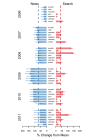A novel evaluation of World No Tobacco day in Latin America
- PMID: 22634568
- PMCID: PMC3799538
- DOI: 10.2196/jmir.2148
A novel evaluation of World No Tobacco day in Latin America
Abstract
Background: World No Tobacco Day (WNTD), commemorated annually on May 31, aims to inform the public about tobacco harms. Because tobacco control surveillance is usually annualized, the effectiveness of WNTD remains unexplored into its 25th year.
Objective: To explore the potential of digital surveillance (infoveillance) to evaluate the impacts of WNTD on population awareness of and interest in cessation.
Methods: Health-related news stories and Internet search queries were aggregated to form a continuous and real-time data stream. We monitored daily news coverage of and Internet search queries for cessation in seven Latin American nations from 2006 to 2011.
Results: Cessation news coverage peaked around WNTD, typically increasing 71% (95% confidence interval [CI] 61-81), ranging from 61% in Mexico to 83% in Venezuela. Queries indicative of cessation interest peaked on WNTD, increasing 40% (95% CI 32-48), ranging from 24% in Colombia to 84% in Venezuela. A doubling in cessation news coverage was associated with approximately a 50% increase in cessation queries. To gain a practical perspective, we compared WNTD-related activity with New Year's Day and several cigarette excise tax increases in Mexico. Cessation queries around WNTD were typically greater than New Year's Day and approximated a 2.8% (95% CI -0.8 to 6.3) increase in cigarette excise taxes.
Conclusions: This novel evaluation suggests WNTD had a significant impact on popular awareness (media trends) and individual interest (query trends) in smoking cessation. Because WNTD is constantly evolving, our work is also a model for real-time surveillance and potential improvement in WNTD and similar initiatives.
Conflict of interest statement
Conflicts of Interest: JWA and BMA share an equity stake in a consulting group, Directing Medicine, that helps others implement some of the ideas embodied in this work. The data generation procedures, however, are not proprietary and rely on public archives. There are no other conflicts of interest relevant to this study.
Editorial note: This paper was originally peer-reviewed by another journal. JMIR reviewed the paper internally and accepted the peer-review reports and the authors' responses as forwarded by the author. Thus, the identity of the reviewers is not known to the editor.
Figures




References
-
- Ezzati M, Lopez AD. Regional, disease specific patterns of smoking-attributable mortality in 2000. Tob Control. 2004 Dec;13(4):388–95. doi: 10.1136/tc.2003.005215. http://tobaccocontrol.bmj.com/cgi/pmidlookup?view=long&pmid=15564623 - DOI - PMC - PubMed
-
- World Lung Foundation, American Cancer Society. [2012-05-17]. The Tobacco Atlas http://www.tobaccoatlas.org/
-
- Centers for Disease Control and Prevention (CDC) Cigarette smoking among adults and trends in smoking cessation - United States, 2008. MMWR Morb Mortal Wkly Rep. 2009 Nov 13;58(44):1227–32. http://www.cdc.gov/mmwr/preview/mmwrhtml/mm5844a2.htm - PubMed
-
- World Health Organization. 2012. May 31, [2012-05-17]. World No Tobacco Day http://www.who.int/mediacentre/events/annual/wntd/en/index.html.
Publication types
MeSH terms
Grants and funding
LinkOut - more resources
Full Text Sources
Medical

